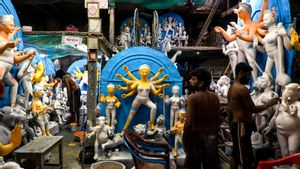Growing up in Delhi, fed on a steady diet of mythology and drama, my earliest memories were of standing in endless fields of grass watching a glorious enactment of the Ram Leela.
Next to my grandmother’s home in Model Town, for just a few rupees, we all went to visit a veritable wonderland, partaking in the festivities around Dussehra. Toy sellers sold swords, bows and arrows and maces made of wood, each carefully wrapped in shiny gold and silver paper sheets. Sweet and snack vendors lolled around the parade ground. Ferris wheels and merry-go-rounds whizzed round and round at a dizzying pace.
In the cacophony of it all, a makeshift stage stood at the centre of the field. Garishly painted sets, including a palace, the forest—Ashok Vatika and Lanka, were pushed in and out of the stage ever so often. Acted out by a motley cast of mostly men, we craned our necks to see the abduction of Sita Mata and Hanuman ji’s decimation of Lanka.
Finally, when the war drew to a close, Lord Rama, who had just stepped off the stage on to a chariot, (and many times on foot depending on the production budget) pierced the bellies of the demons’ effigies: Ravan, Kumbhakarn and Meghanath with a blazing arrow.
We watched the straw demons go up in a blaze of fireworks, each collapsing in slow motion, nearly missing the screaming crowds who ventured too close. Amidst a sea of people, my eyes were filled with stars while flames leapt into the sky. A memory that has stayed on for decades.
Living traditions
When the blooms of night jasmine or raat ki rani’s perfume filled Delhi’s air, you knew that autumn was making way for winter, and that Dussehra was around the corner. Sweeping across northern India, Ram Leela, a condensed form of Ramayana with songs, narration, recital and dialogue is performed. The vivid dramatisation of Ramcharitamanas is based on the Hindi text penned by Tulsidas, who made the Sanskrit epic accessible to all.
In 2008, UNESCO inscribed the performance of Ram Leela as an Intangible Cultural Heritage of Humanity that brought communities together, without distinction of caste, religion or age, involving those of all faiths in the performance, from playing roles to designing costumes. But in recent times, with the emergence of TV, this euphoria has dimmed.
This popular form of storytelling has iconic centres which have been performing for centuries: Ayodhya, Ramnagar in Varanasi, Vrindavan, Almora, Satna and Madhubani. The glory of Lord Ram is enacted out in a series of performances, spread over 9 days to 12 days, and sometimes even a period of a month, such as at Varanasi’s Ramnagar, where the Ram Leela tradition has continued for nearly five centuries. This magnum opus has been nurtured under the aegis of the royal family of Varanasi. The Ramnagar Ramleela is held across different locations of the town and over a million visitors throng the city to watch.

Revisiting Ram Leela
One of my favourite Ram Leela was the one enacted by Delhi’s Shriram Bharatiya Kala Kendra, a production that has continued for over 60 years. Every year, all the cousins would be bundled up to watch this immaculately detailed production, an iconic dance ballet. I remember when we were very young, a monkey from the vanar sena leapt onto my baby brother’s lap, who wailed his lungs out for the rest of the night.
Over the years the production has evolved to keep up with the times. By the time my nephew and niece witnessed the dance drama, painted backdrops had made way for digital screens and the costumes were more lavish and sophisticated. Voices of the characters were more definitive; Sita Mata and Lakshmana, rather than just playing mute spectators, fated to a destiny they did not choose, were shaping their narrative.
After I moved to Mumbai, the memories of Dussehra slowly faded. But good fortune brought Lord Rama right to my doorstep when a travelling all-male troop from Moradabad visited my sister’s condo in Gurugram. The five-hour non-stop performance by Sri Ram Singh Chitrakar started in 1965, by a gentleman, Yogendra Singh Raju’s father. Thirty male actors took to stage, reprising roles from the epic.
The role of Ravan was played by an actor called Rahul, who had won accolades in many reality shows. Raju, a criminal lawyer, who played the role of Lord Rama, said the act gave him strength and good fortune.
As I watched the children mesmerised by Ravan’s rambunctious laugh and Sita Mata’s piety, I knew that the tradition was in good hands, to be enjoyed by generations for the years to come.




